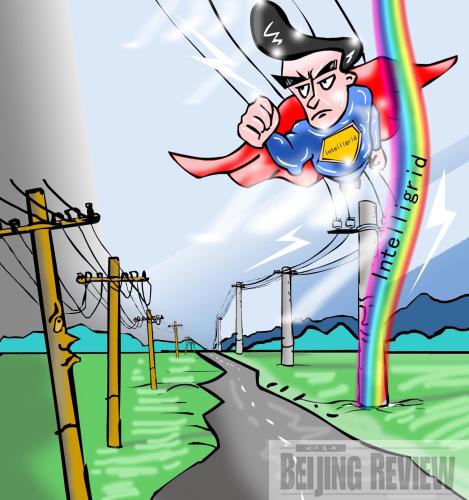|
 |
|
(LI SHIGONG) |
Rejoicing over its burgeoning economy over the last three decades, China now finds itself struggling with an inadequate power supply over the long term. The pain is only worsened by the national power grid's failures in dynamic power distribution, the fact that China's booming east lacks energy reserves and the country's limited use of renewable energies. The solution to all these problems is to revolutionize China's power grid into a smart grid.
Liu Zhenya, President of the State Grid Corp. of China (SGCC), China's only power distribution company, said recently that China has embarked on building a reliable world-leading smart grid featuring ultra-high-voltage power transmission, information and automated technologies.
The smart grid, first put forward by the California-based Electric Power Research Institute as Intelligrid, refers to a next-generation electricity network featuring the infusion of modern information and communications technology into every aspect of electricity generation, delivery and consumption. "Improved efficiency, cleanness, flexibility and reliability are the four features of a smart grid," said He Guangyu, an associate professor at Tsinghua University in Beijing.
To ordinary consumers, like those going through the Northeast Blackout in the United States in 2003, the most noticeable benefit of a smart grid is its self-healing capacity to prevent service disruptions. Since the system uses real-time information from embedded sensors and automated controls to anticipate, detect and respond to system problems, a smart grid can automatically avoid or mitigate power outages.
In the near future, the smart grid will enable clients of the power system as well as power suppliers to learn the real-time supply and demand throughout entire cities. Power consumers will be able to rearrange their activities and actively participate in the grid's operations.
Advocates of the smart grid even envision the use of differentiated power pricing over time to reduce the fluctuation of the total load connected to the power grid throughout the day. For example, the electricity price would be raised in the evening, when peak electric demand usually occurs, to motivate residential clients to put off some electricity-consuming housework to off-peak times.
Under the smart grid, clients would be able to use the grid to personalize their control strategy for different family appliances. For example, the preset software in the control system would raise the temperature of the home air-conditioning system after residents go to work and turn the temperature down after they come back. The smart grid also allows clients to conduct long-distance remote control of family appliances.
The transformation of China's traditional power grid into the smart grid will be completed by 2020, and will involve power generation, transmission, transformation and distribution. During the first stage, from 2009 to 2010, the focus will stay on development of key technologies, equipment and pilot projects. During the second phase, from 2011 to 2015, priority will be given to constructing an ultra-high-voltage power grid and power distribution network. The SGCC estimated that the company's total investment in the deployments would reach 4 trillion yuan ($588 billion) by the end of the last stage, from 2016 to 2020.
So far, China and the United States have invested heavily in research and deployment for the smart grid. When U.S. Secretary of Commerce Gary Locke and Secretary of Energy Steven Chu visited China in July, both went to the SGCC to explore the two countries' technical cooperation in building the smart grid and using clean energies.
Chinese energy expert Wu Jiandong believes that the smart grid represents the optimal way to reshape the global electricity delivery system and raise energy efficiency.
| 